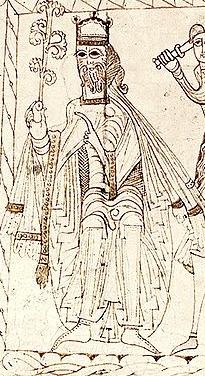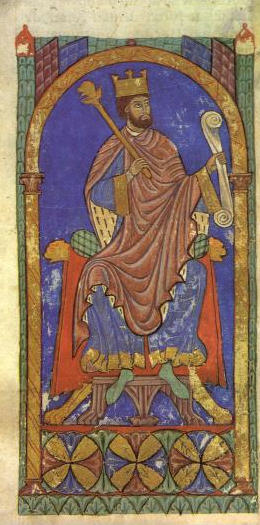Alfonso VII of León and Castile facts for kids
Quick facts for kids Alfonso VII |
|
|---|---|

Alfonso as emperor, from a Privilegium Imperatoris issued by him.
|
|
| King of León and Castile | |
| Reign | 1126 – 1157 |
| Coronation | 1135 in the Cathedral of León |
| Predecessor | Urraca |
| Successor | Sancho III (Castile) Ferdinand II (León) |
| King of Galicia | |
| Reign | 1111 – 1157 |
| Predecessor | Urraca |
| Successor | Ferdinand II |
| Emperor of All Spain | |
| Reign | 1126–1157 |
| Predecessor | Urraca |
| Co-monarch | Alfonso the Battler (1126-1134) |
| Born | 1 March 1105 Caldas de Reis |
| Died | 21 August 1157 (aged 52) Sierra Morena |
| Burial | Cathedral of Toledo |
| Spouse | Berenguela of Barcelona Richeza of Poland |
| Issue among others... |
Sancho III, King of Castile Ferdinand II, King of Léon Constance, Queen of France Sancha, Queen of Navarre Sancha, Queen of Aragon (illeg.) Urraca, Queen of Navarre (illeg.) Stephanie Alfonso |
| House | House of Burgundy |
| Father | Raymond, Count of Galicia |
| Mother | Urraca, Queen of León and Castile |
| Religion | Roman Catholicism |
Alfonso VII (born 1 March 1105 – died 21 August 1157) was a very important king in the history of Spain. He was often called the Emperor (el Emperador). He became the King of Galicia in 1111 and later the King of León and Castile in 1126.
Alfonso was born as Alfonso Raimúndez. He was the first ruler to use the title Emperor of All Spain. He first used this title with his mother, Urraca of León, when she gave him control of Toledo in 1116. In 1135, he had a big ceremony to show his claim to the imperial title. Alfonso was the son of Queen Urraca of León and Raymond of Burgundy.
Alfonso was a respected and interesting leader. During his rule, the Christian kingdoms in western Iberia (like León and Castile) became stronger than the eastern ones (like Navarre and Aragón). He wanted the imperial title to be meaningful for both Christian and Muslim people, but his big plans didn't fully happen. During his time, Portugal became independent in 1128 and was officially recognized in 1143. Alfonso also supported poets, like the famous troubadour Marcabru.
Contents
Becoming King of Three Kingdoms
In 1111, when Alfonso was still a child, Diego Gelmírez, the Bishop of Compostela, crowned him King of Galicia. His mother, Urraca, had become queen of León, Castile, and Galicia in 1109. She wanted to make sure her son would become king after her.
By 1125, Alfonso had also inherited the former Muslim Kingdom of Toledo. On March 10, 1126, after his mother died, he was crowned in León. He immediately started to take back the Kingdom of Castile, which was then controlled by Alfonso the Battler. In 1127, a peace treaty called the Peace of Támara was signed, and Alfonso the Battler recognized Alfonso VII as King of Castile.
However, the areas in the far east of his kingdom had become very independent during his mother's rule. They had many rebellions. After being recognized in Castile, Alfonso had to fight to control the local lords.
When Alfonso the Battler, who was King of Navarre and Aragón, died in 1134 without children, he left his kingdom to the Knights Templar and the Knights Hospitaller. But the nobles in both kingdoms didn't agree with this. García Ramírez of Navarre was chosen as king in Navarre. Alfonso VII tried to claim the throne of Aragón for himself. But the nobles there chose the dead king's brother, Ramiro II, instead.
Alfonso then took back La Rioja and tried to add the areas around Zaragoza and Tarazona to his kingdom. He won some battles against the armies of Navarre and Aragón, making them his vassals. He also had strong support from lords north of the Pyrenees mountains. But in the end, the combined forces of Navarre and Aragón were too strong for him to fully control. Around this time, he also helped Ramon Berenguer III, Count of Barcelona, unite the old Marca Hispanica (a border region) in his wars against other Catalan counties.
Imperial Rule and Reconquista
For a long time, there was a tradition that the ruler who held León could be called "emperor." Even Sancho the Great used the title "Emperor of All Spain" after being crowned in León. This title meant the ruler was seen as a direct link to the old Visigothic kings, who were like representatives of the Roman Empire. But even though it appeared in documents, and was claimed by Alfonso VI and Alfonso the Battler, the title was mostly just a fancy word.
On May 26, 1135, Alfonso was crowned "Emperor of Spain" in the Cathedral of León. By doing this, he probably wanted to show his power over the whole Iberian Peninsula and his leadership in the Reconquista (the Christian reconquest of Spain from Muslim rule). He tried to create a united Spain, which hadn't existed since the fall of the Visigothic kingdom. But the different parts of Spain were hard to bring together.
The weakness of Aragón allowed him to show his power there. In 1137, Afonso Henriques of Portugal recognized Alfonso VII as his lord. However, Alfonso VII lost the Battle of Valdevez in 1141, which helped Portugal become truly independent. In 1143, Alfonso himself recognized Portugal's independence in the Treaty of Zamora (1143). Also in 1143, he agreed to the marriage of Petronila of Aragon with Ramon Berenguer IV, Count of Barcelona. This marriage joined Aragón and Catalonia, forming the Crown of Aragon.
Wars Against Al-Andalus
Alfonso was a very religious king. He brought the Cistercian monks to Iberia by starting a monastery at Fitero. He took a strong stand against the Moors (Muslims) of Al-Andalus, especially the Almoravids. Starting in 1138, when he attacked Coria, Alfonso led many crusades to conquer the Almoravids.
In 1142, Alfonso attacked Coria a second time and captured it. In 1144, he marched as far as Córdoba. Two years later, a new Muslim group called the Almohads invaded. Alfonso had to strengthen his southern border and make a deal with the Almoravid leader Ibn Ganiya to defend against the Almohads together.
When Pope Eugene III called for the Second Crusade, Alfonso VII, along with García Ramírez of Navarre and Ramon Berenguer IV, led an army. This army included people from Catalonia and Franks (from France), supported by ships from Genoa and Pisa. They went on a crusade against the rich port city of Almería, which they captured in October 1147. A third of the city was given to Genoa. This was Castile's first port on the Mediterranean Sea.
In 1151, Alfonso signed the Treaty of Tudilén with Ramon Berenguer. This treaty set out which areas in Andalusia each ruler could conquer, to avoid conflicts between them. Six years later, Almería was taken by the Almohads. Alfonso was returning from a trip against them when he died on August 21, 1157, in Las Fresnedas, north of the Sierra Morena mountains.
Alfonso's Legacy
Alfonso supported the church and also protected the Muslims who lived in his kingdom, even though they were a minority. His rule ended with a difficult campaign against the growing power of the Almohads. He wasn't truly defeated, but his death while returning to Toledo showed that no one could truly be "king of the men of the two religions" (Christians and Muslims) as he claimed. Also, by dividing his kingdom between his sons, he made sure that the Christian kingdoms would not be united against the new Almohad threat.
Family
In November 1128, Alfonso married Berenguela of Barcelona, the daughter of Ramon Berenguer III, Count of Barcelona. She died in 1149. Their children were:
- Ramón (lived in 1136, died young)
- Sancho III of Castile (1134–1158)
- Ferdinand II of León (1137–1188)
- Constance (around 1138–1160), who married Louis VII of France
- Sancha (around 1139–1179), who married Sancho VI of Navarre
- García (around 1142–1145/6)
- Alfonso (1144/1148–around 1149)
In 1152, Alfonso married Richeza of Poland, the daughter of Ladislaus II the Exile. They had:
- Ferdinand (1153–1157)
- Sancha (1155–1208), who married Alfonso II of Aragón.
Alfonso also had children with two other women. With an Asturian noblewoman named Gontrodo Pérez, he had a daughter, Urraca (1132–1164), who married García Ramírez of Navarre. Later, he had a daughter named Stephanie the Unfortunate (1148–1180) with Urraca Fernández. Stephanie was sadly killed by her husband, Fernán Ruiz de Castro.
Family Tree
See also
 In Spanish: Alfonso VII de León para niños
In Spanish: Alfonso VII de León para niños
Images for kids



